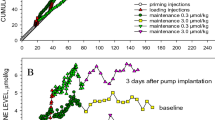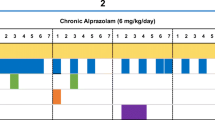Abstract
After 3 days of dosing rats with lorazepam (0.25 mg/kg), tolerance developed to its sedative effects. Recovery from this tolerance was rapid. No differences could be detected in undrugged behaviour 24 h after the last dose and no differences in response to a probe injection could be found when 2 drug-free days intervened between the chronic treatment and test dose. RO 15-1788 (1–4 mg/kg) antagonised the sedative effects of acute lorazepam (0.5 and 0.25 mg/kg), but chronic treatment with these doses concomitantly with lorazepam did not prevent the development of tolerance. However, 4 mg/kg RO 15-1788 administered for 5 days at the same time as lorazepam (0.5 mg/kg) and again 45 min later attenuated the development of tolerance. Plasma concentrations after acute and chronic treatment did not differ for 0.25 mg/kg lorazepam, but they were lower following chronic treatment with 0.5 mg/kg. Therefore the development of behavioural tolerance in rats to the sedative effects of benzodiazepines probably involves changes in benzodiazepine receptors, in addition to a pharmacokinetic contribution after treatment with high doses.
Similar content being viewed by others
References
Braestrup C, Nielsen M, Squires RF (1979) No changes in rat benzodiazepine receptors after withdrawal from continuous treatment with lorazepam and diazepam. Life Sci 24:347–350
Cook L, Sepinwall J (1975) Behavioral analysis of the effects and mechanisms of action of benzodiazepines. In: Costa E, Greengard P (eds) Mechanisms of action of benzodiazepines. Raven, New York, pp 1–28
Duncan DB (1955) Multiple range and multiple F tests. Biometrics 11:1–42
File SE (1981) Rapid development of tolerance to the sedative effects of lorazepam and triazolam in rats. Psychopharmacology 73:240–245
File SE, Hyde JRG (1978) Can social interaction be used to measure anxiety?. Br J Pharmacol 62:19–24
File SE, Wardill AG (1975a) The reliability of the holeboard apparatus. Psychopharmacologia 44:47–51
File SE, Wardill AG (1975b) Validity of head-dipping as a measure of exploration in a modified holeboard. Psychopharmacologia 44:53–59
Greenblatt DJ, Franke K, Shader RI (1978) Analysis of lorazepam and its glucuronide metabolite by electron-capture gas-liquid chromatography. J Chromatography 146:311–320
Greenblatt DJ, Shader RI (1974) Benzodiazepines in clinical practice. Raven, New York
Hunkeler W, Mohler H, Pieri L, Polc P, Bonetti EP, Cumin R, Schaffner R, Haefely W (1981) Selective antagonists of benzodiazepines. Nature 290:514–516
Lloyd KG, Bovier P, Broekkamp CL, Worms P (1981) Reversal of the antiaversive and anticonvulsant actions of diazepam, but not of progabide, by a selective antagonist of the benzodiazepine receptors. Eur J Pharmacol 7:77–78
Mohler H, Okada T, Enna SJ (1978) Benzodiazepine and neurotransmitter receptor binding in rat brain after chronic adminsstration of diazepam and phenobarbital. Brain Res 156:391–395
Nutt DJ, Cowen PJ, Little HJ (1982) Unusual interactions of benzodiazepine receptor antagonists. Nature 295:436–438
Rosenberg HC, Chiu TH (1979) Decreased 3H-diazepam binding is a specific response to chronic benzodiazepine treatment. Life Sci 24:803–808
Rosenberg HC, Chiu TH (1981) Tolerance during chronic benzodizzepine treatment associated with decreased receptor binding. Eur J Pharmacol 70:453–460
Stein L, Berger BD (1971) Psychopharmacology of 7-chloro-5-(O-chlorophenyl)-1,3-dihydro-3-hydroxy-2H-1,4-benzodiazepin-2-one (lorazepam) in squirrel, monkey and rat. Arzneim Forsch 21:1073–1078
Author information
Authors and Affiliations
Additional information
Wellcome Trust Senior Lecturer
Rights and permissions
About this article
Cite this article
File, S.E. Recovery from lorazepam tolerance and the effects of a benzodiazepine antagonist (RO 15-1788) on the development of tolerance. Psychopharmacology 77, 284–288 (1982). https://doi.org/10.1007/BF00464581
Received:
Issue Date:
DOI: https://doi.org/10.1007/BF00464581




